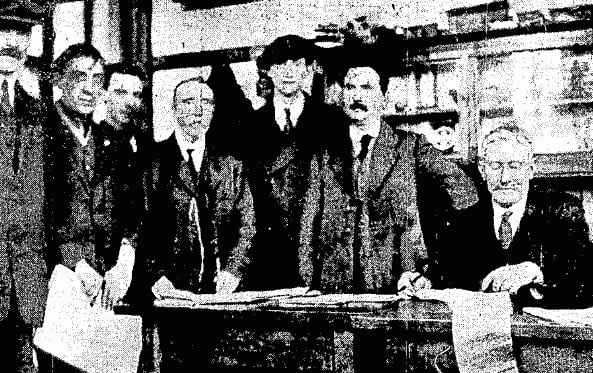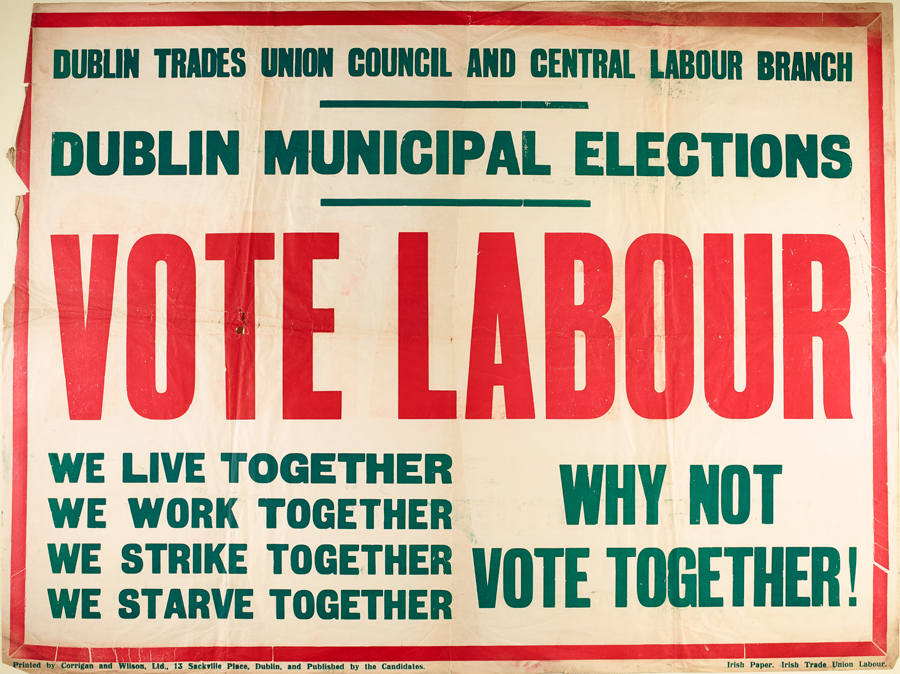Municipal elections – Sinn Féin and Labour perform strongly as unionists falter
Dublin, 19 January 1920 - Just over a year after the party surged to a remarkable victory in the general election, Sinn Féin has again emerged as the country’s dominant political force in the municipal elections. However, the picture that has emerged is more fragmented than that revealed in the wake of the December 1918 vote.
This is largely attributable to the system of proportional representation that has been used and the increased level of political competition in many areas, particularly from Labour candidates. Absent from the general election in 1918, Labour candidates secured a total of 329 seats in the municipal elections, taking from the Sinn Féin and unionists vote in different parts of the country.
Dublin
In Dublin, Sinn Féin secured a majority on the council by
winning an additional 18 seats to take their total to 42 seats.
For the moment, however, the party will only be able to occupy 38
seats which will prevent them from operating an actual working
majority.
This is because Kathleen Clarke (née Daly) was returned as an alderman for two constituencies, Seán T. O’Kelly is in Paris, and Thomas Kelly and Sean O’Mahony are in jail.

Scenes from the elections in Dublin. Right: children crowd around a candidate in one of the wards. Centre: children marching in support of their candidate of choice, probably James Gately, an independent nationalist. Right: Kathleen Clarke, Sinn Féin candidate, who was elected in two constituencies. (Images: Irish Life, 23 January 1920 & The Catholic Bulletin, December 1916)
The breakdown of parties and votes in Dublin are as follows:
Sinn Féin - 28,133 votes, 42 seats
Labour - 9,648 votes, 14 seats
Nationalists (including Irish Parliamentary Party) - 7,924 votes, 13 seats
Municipal Reformers - 8,530 votes, 10 seats
A single unionist was also returned.
All Sinn Féin MPs who stood for election were elected in Dublin, among them William T. Cosgrave, who topped the poll in Kilmainham and Usher’s Quay.
Five women, all Sinn Féiners, were returned in Dublin City, including Clarke and Nell Humphreys (née O’Rahilly) in Pembroke. Women fared even better in the townships of Dublin, with 12 women returned, six of them in Rathmines alone.
Also among the successful Sinn Féin candidates were a number of ex-civil servants who were dismissed from their posts for refusing to swear an oath of allegiance to the crown.
North-East
The strongest unionist showing was in the north-east of the
country, yet there was some surprise that unionism didn’t
enjoy as strong a performance as might have been expected. Where
official unionists held 52 seats on the old Belfast City Council,
they will now occupy 35 (alongside two ‘Independent’
Unionists) in the new chamber.
Sinn Féin and the nationalists have each returned five members to the council – the nationalists held eight seats on the old council. But while nationalism has made slight gains in Belfast, the principle reason for the fall in unionist seats is the rise of Labour which claimed 13 seats.
There were also setbacks for unionism in other parts of Ulster. They are now in a minority in Downpatrick and Omagh, areas where they’ve traditionally held sway. In Dungannon, their two to one majority has been reduced to just a single seat. In Newry, they fell from six seats to four.
Clashes in Cork
By and large, the elections and the result declarations, passed
without serious incident. In Cork, however, violent clashes
erupted between Sinn Féin supporters and ex-soldiers on
polling day, which left one man with a bullet wound in his arm and
another with a stab wound in the thigh.
The Sinn Féiners, it is understood, had been parading with sticks nearing the Mechanics’ Hall polling station in the city when they were confronted by ex-soldiers and chased down Grattan Street and on to Adelaide Street. Sinn Féiners in Liam de Róiste, J.J. Walsh and Terence MacSwiney were all elected.

A polling station in Cork City, where the presiding officer was well known athlete Dan Murphy (Image: Cork Examiner, 16 January 1920)
With 56 seats up for grabs, over 50 of the candidates were drawn from two political groupings: Sinn Féin and Labour. The Cork Examiner has reacted positively to the results and has devoted an editorial to setting out the possibilities for the city and county’s commercial and industrial improvement.
‘Cork now stands on the edge of opportunities which, if wisely handled, should bring prosperity to the city and provide an abundance of employment for all classes. Upon her public representatives much depends. If they be wise, tolerant, progressive and broadminded, the outlook is full of promise.’
[Editor's note: This is an article from Century Ireland, a fortnightly online newspaper, written from the perspective of a journalist 100 years ago, based on news reports of the time.]





















